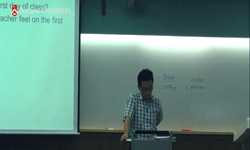Schiffrin (1987) defines discourse markers (henceforth DMs) as “sequentially dependent elements which bracket units of talk” (p. 276). DMs have been regarded as a signpost used by a speaker to display a certain attitude or embedded intention in a ...
http://chineseinput.net/에서 pinyin(병음)방식으로 중국어를 변환할 수 있습니다.
변환된 중국어를 복사하여 사용하시면 됩니다.
- 中文 을 입력하시려면 zhongwen을 입력하시고 space를누르시면됩니다.
- 北京 을 입력하시려면 beijing을 입력하시고 space를 누르시면 됩니다.
https://www.riss.kr/link?id=A105228750
- 저자
- 발행기관
- 학술지명
- 권호사항
-
발행연도
2017
-
작성언어
English
- 주제어
-
등재정보
KCI등재후보
-
자료형태
학술저널
-
수록면
41-65(25쪽)
- 제공처
- 소장기관
-
0
상세조회 -
0
다운로드
부가정보
다국어 초록 (Multilingual Abstract)
Schiffrin (1987) defines discourse markers (henceforth DMs) as “sequentially dependent elements which bracket units of talk” (p. 276). DMs have been regarded as a signpost used by a speaker to display a certain attitude or embedded intention in a spoken discourse. However, few studies have investigated how DMs are used in a spoken discourse of English as Foreign Language (henceforth EFL) learning context. The purpose of the present study is to examine how okay is used as a DM by Korean teachers of English in their naturally-occurring discourses of EFL classes. The data for this study was obtained from recorded videos of English classes taught by six Korean teachers of English. The data were transcribed verbatim and analyzed on the basis of the Conversation Analysis framework. The multifunctional use of the DM okay deployed by the teachers can be classified as follows: (ⅰ) getting attention, (ⅱ) signaling approval and acceptance as a feedback device, and (ⅲ) working as a transition activator.
목차 (Table of Contents)
- Ⅰ. Introduction
- Ⅱ. Theoretical Background
- 2.1 Discourse markers and Multifunctionality
- 2.2 Discourse marker okay
- Ⅲ. Methodology
- Ⅰ. Introduction
- Ⅱ. Theoretical Background
- 2.1 Discourse markers and Multifunctionality
- 2.2 Discourse marker okay
- Ⅲ. Methodology
- 3.1 Data
- 3.2 Data Analysis
- Ⅳ. Result and Discussion
- 4.1. The Cognative Function; Getting Attention
- 4.2. The Expressive Function; Signaling Approval and Acceptance as a Feedback Device
- 4.3. The Metadiscursive Function; Working as a Transition Activator
- Ⅴ. Conclusion
- REFERENCES
동일학술지(권/호) 다른 논문
-
Predicting L2 Writing Proficiency with Computational Indices Based on N-grams
- 서울대학교 외국어교육연구소
- Byung-Doh Oh
- 2017
- KCI등재후보
-
Effects of Different Types of Written Corrective Feedback on Korean High School Students’ Writing
- 서울대학교 외국어교육연구소
- Jungeun Choi
- 2017
- KCI등재후보
-
Perception of English Needs: Voices from Employers and Employers of a Leading ICT Company in Korea
- 서울대학교 외국어교육연구소
- Soh Yon Chung
- 2017
- KCI등재후보
-
핵심역량 기반 프로젝트형 학습을 위한 독일어 수업모델 연구
- 서울대학교 외국어교육연구소
- 박현선
- 2017
- KCI등재후보





 코리아스칼라
코리아스칼라



